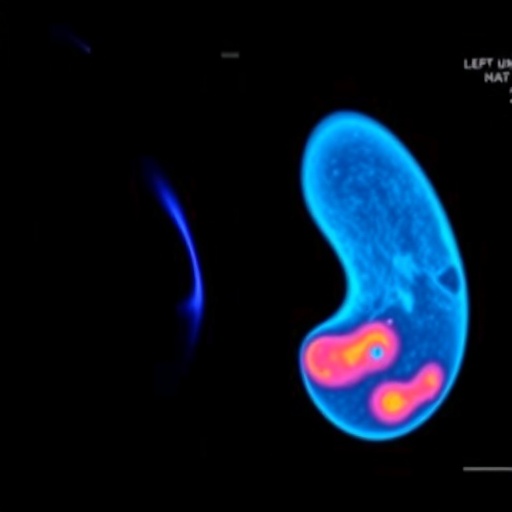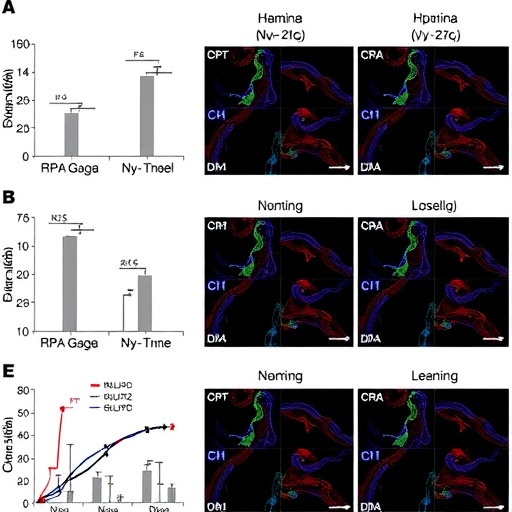Recent advancements in cancer treatment have unveiled the potential for technologically enhanced therapies to significantly improve outcomes for patients diagnosed with aggressive cancers. In a groundbreaking study led by researchers Li, Zhong, and Zhang, published in the renowned journal BMC Pharmacology and Toxicology, the effects of ultrasound-stimulated microbubble cavitation on the efficacy of Lenvatinib—a commonly used targeted therapy for anaplastic thyroid cancer—were thoroughly investigated. This study not only heightens our understanding of therapeutic techniques but also opens avenues for innovative cancer treatment protocols.
The mechanism through which ultrasound impacts microbubble cavitation is both fascinating and complex. Microbubbles, typically composed of gas encapsulated in a lipid or polymer shell, have been used for a range of applications in medical imaging and targeted drug delivery. When exposed to ultrasound waves, these microbubbles oscillate and can undergo stable and inertial cavitation—processes that lead to localized energy release and can enhance the permeability of cellular membranes. This dynamic interaction allows for increased absorption of therapeutic agents within target tissues, paving the way for more effective treatments.
Lenvatinib, a tyrosine kinase inhibitor, has been employed as a standard treatment for anaplastic thyroid cancer, known for its aggressiveness and poor prognosis. While effective, the limitation of drug delivery and the development of resistance remain significant hurdles in its treatment. The introduction of ultrasound-guided microbubble cavitation serves as a novel strategy to overcome these challenges. By improving the targeted delivery of Lenvatinib directly to the cancerous tissues, the chance of achieving higher therapeutic concentrations at the tumor site is significantly increased, thereby enhancing treatment efficacy.
The research team set out to explore this hypothesis by conducting a series of carefully orchestrated experiments. In vitro models of anaplastic thyroid cancer were treated with Lenvatinib, both with and without the application of ultrasound-stimulated microbubble cavitation. The findings revealed compelling evidence that the presence of ultrasound significantly augmented the anticancer effects of the medication. Cell viability assays demonstrated a marked reduction in cancer cell proliferation when treatments were combined, showcasing the synergistic potential of this combination therapy.
The in vivo component of the study fortified these findings, as animal models treated with ultrasound-activated microbubbles alongside Lenvatinib exhibited improved tumor suppression. The researchers noted a substantial increase in tumor necrosis, which was indicative of enhanced drug uptake facilitated by cavitation effects. Such promising results suggest that the integration of ultrasound technology into standard treatment regimens could be a game-changer for patients grappling with aggressive forms of thyroid cancer.
However, the implications of this study extend beyond just Lenvatinib and anaplastic thyroid cancer; they provide a glimpse into the future of cancer therapy as a whole. The use of ultrasound-mediated treatments may offer new avenues for enhancing drug delivery across various malignancies and therapeutic agents. In essence, the findings underscore the promise of combination therapies that leverage the power of physical techniques alongside conventional pharmacological approaches.
Safety considerations are, of course, paramount when integrating novel technologies into existing treatment paradigms. In assessing the safety profile of ultrasound-stimulated microbubbles, the researchers conducted comprehensive analyses to monitor potential adverse effects. Encouragingly, results revealed that the combination treatments did not induce added toxicity, which is critical when considering translations to clinical settings. Careful monitoring and optimization of ultrasound parameters further ensure that the therapies remain well within the safety margins established for oncological treatments.
This research adds a vital layer to the growing body of evidence supporting the utilization of innovative delivery mechanisms in oncology. Future clinical trials will be crucial in determining the efficacy and safety of employing ultrasound-stimulated microbubble cavitation in human subjects. Researchers anticipate that positive outcomes could lead to the adaptation of this technology as a standard practice in cancer treatment protocols, enhancing survival rates and improving quality of life for patients.
The blend of technology and medicine as evidenced in this study not only bridges gaps in targeted therapy but also emphasizes the importance of interdisciplinary collaboration in scientific research. By engaging biomedical engineers, oncologists, and pharmacologists, the study exemplifies how collaborative efforts can yield innovative solutions that could potentially revolutionize cancer treatment.
As the scientific community eagerly awaits further validation of these findings through clinical trials, the implications of this research serve as a beacon of hope. Patients diagnosed with anaplastic thyroid cancer may one day benefit from enhanced treatment options that provide more favorable prognoses and optimized efficacy through tailored therapeutic strategies. The path to comprehensively understanding the full potential of ultrasound-mediated therapies is still nascent, but studies such as this lay the groundwork for transformative advancements.
Next steps for research will likely involve refining ultrasound parameters for optimized cavitation effects and exploring combination therapies beyond Lenvatinib. With continuous advancements in imaging and drug delivery technologies, the prospect of employing personalized medicine in the treatment of cancers is increasingly within reach. The search for more effective treatment modalities has just begun, paving the way for revolutionary changes in cancer care.
In summary, the evidence presented by Li, Zhong, Zhang, and colleagues illuminates a promising frontier in cancer treatment. Employing ultrasound-stimulated microbubbles to enhance the effects of Lenvatinib on anaplastic thyroid cancer epitomizes the future of integrative medicine, showcasing how innovative techniques can complement traditional therapies. As research progresses, we edge closer to a world where cancer can be fought with precision and efficacy, offering new hope to patients everywhere.
Subject of Research: Ultrasound-stimulated microbubble cavitation enhancement of Lenvatinib’s anticancer effects
Article Title: Ultrasound stimulated microbubble cavitation promoted the anticancer effect of Lenvatinib on anaplastic thyroid cancer
Article References:
Li, S., Zhong, R., Zhang, A. et al. Ultrasound stimulated microbubble cavitation promoted the anticancer effect of Lenvatinib on anaplastic thyroid cancer. BMC Pharmacol Toxicol 26, 171 (2025). https://doi.org/10.1186/s40360-025-00995-z
Image Credits: AI Generated
DOI: 10.1186/s40360-025-00995-z
Keywords: microbubble cavitation, Lenvatinib, anaplastic thyroid cancer, ultrasound therapy, drug delivery, cancer treatment, targeted therapy, personalized medicine.
Tags: anaplastic thyroid cancer treatment innovationscancer treatment advancements 2023innovative cancer treatment protocolslenvatinib efficacy enhancementlocalized energy release in medicinemechanisms of ultrasound in cancer therapymicrobubble cavitation in drug deliverytargeted therapy for aggressive cancerstherapeutic techniques for thyroid cancertyrosine kinase inhibitors in oncologyultrasound therapy for cancer treatmentultrasound-stimulated drug absorption





